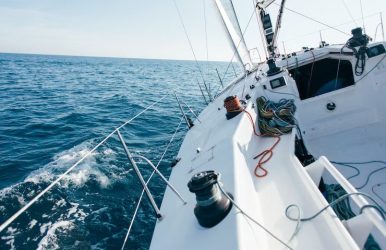Ways To Reduce The Carbon Footprint When Sailing
BY Mony ShahSep 20, 2023
Sailing is a timeless and exhilarating way to traverse the world's waterways, offering a unique connection with nature and the elements. However, like many activities, sailing contributes to carbon emissions and environmental degradation. As the world grapples with the consequences of climate change, sailors and sailing enthusiasts must adopt sustainable practices to minimize their carbon footprint. Here Are 10 Crucial Steps To Reduce The Carbon Footprint When Sailing In this comprehensive guide, we will explore various strategies and techniques to help reduce the environmental impact of sailing while preserving the beauty of our oceans and water bodies. 1. Choose Sustainable Sailing Vessels The first step in reducing your carbon footprint when sailing is to choose a vessel that aligns with sustainability goals. Modern sailboats come in various designs, and many now incorporate eco-friendly features. Look for boats with energy-efficient systems, such as electric or hybrid propulsion, solar panels, and wind turbines. These innovations can significantly reduce your reliance on fossil fuels. 2. Practice Efficient Sailing Techniques Efficiency in sailing not only enhances your enjoyment but also reduces your carbon footprint. Here are some techniques to consider: ● Optimise Sail Trim: Properly trim your sails to capture the wind efficiently. This increases your speed and reduces the need for auxiliary propulsion.● Sail in the Right Wind Conditions: Choose your sailing days wisely. Sailing in optimal wind conditions allows you to use your sails more effectively and reduces engine usage.● Avoid Overloading: Keep your sailboat's weight within its recommended limits. Overloaded boats are less efficient and require more power to move.● Sail More, Motor Less: One of the most effective ways to reduce your carbon footprint while sailing is to rely on wind power as much as possible. Whenever conditions permit, sail instead of using the engine. Sailors often describe the sensation of harnessing the wind's energy as one of the most rewarding aspects of the sport. 3. Plan Efficient Routes Careful route planning can significantly reduce fuel consumption and emissions. Consider the following when planning your sailing trips: ● Use Weather Forecasts: Utilise weather forecasts to plan routes that take advantage of prevailing winds and currents.● Avoid Unnecessary Detours: Plan direct routes between destinations to minimize the distance sailed and fuel consumed.● Opt for Downwind Sailing: Whenever possible, choose routes that allow you to sail downwind, as this requires less effort and engine power. 4. Maintain Your Sailboat Regular maintenance is essential for keeping your sailboat in peak condition and reducing its environmental impact. Well-maintained boats operate more efficiently and require fewer repairs. Ensure your boat's engine is regularly serviced to maintain optimal fuel efficiency and repair any leaks to prevent oil or fuel spills. 5. Reduce Energy Consumption Sailboats are equipped with various electrical systems, including navigation equipment, lighting, and communication devices. To reduce energy consumption: ● Switch to LED Lighting: Replace traditional bulbs with energy-efficient LED lighting to minimize power usage.● Use Energy-Conserving Appliances: Invest in low-power appliances to reduce your boat's energy consumption.● Manage Energy Consumption: Turn off unnecessary electronic devices and implement energy-saving practices aboard when not in use. 6. Sustainable Provisioning Provisioning for extended sailing trips often involves packaging and waste generation. Opt for sustainable and eco-friendly packaging for your supplies. Consider reusable containers and avoid single-use plastics whenever possible. 7. Responsible Waste Management Implement a rigorous waste management plan aboard your sailboat. Dispose of waste responsibly at designated facilities when you reach the port. Never discharge trash or wastewater into the ocean, as this contributes to pollution and harm to marine life. 8. Support Clean Marina Initiatives When choosing marinas and anchorages, support those that have adopted clean and sustainable practices. Many marinas now have programs in place to minimize their environmental impact, including recycling, wastewater management, and renewable energy usage. 9. Educate And Advocate Spread awareness about sustainable sailing practices among fellow sailors and the broader community. Advocate for environmentally responsible practices within the sailing community and encourage marinas and charter companies to adopt greener technologies and policies. 10. Use Yacht Charters Instead of Buying Opting for luxury yacht charters over purchasing one significantly reduces the carbon footprint by minimizing resource-intensive yacht manufacturing and maintenance. Charter companies often prioritize energy-efficient technologies and sustainable practices, while yacht ownership entails continuous resource consumption, high emissions, and substantial upkeep costs. You can also choose catamarans on your yacht charter, which rely on its sails, reducing its energy consumption. This choice promotes a more environmentally responsible approach to yachting, making it an eco-conscious and efficient way to enjoy luxury sailing experiences while mitigating environmental impact. Start Sailing Green Yachting offers a unique opportunity to explore the world's oceans in style and comfort, but it also comes with a responsibility to minimize its environmental impact. By making conscious choices, such as selecting sustainable yachts, adopting efficient sailing practices, and supporting eco-friendly yacht charters, you can enjoy your sailing experience while reducing your carbon footprint. In doing so, you contribute to preserving our planet's precious oceans and ensure that future generations can continue to enjoy the wonders of sailing. As you embark on your next adventure, remember that luxury and sustainability can coexist harmoniously, creating unforgettable memories on the high seas while preserving the natural beauty of our oceans for generations to come. Read Also: Paradise Found: Exploring Manuel Antonio, Costa Rica’s Tropical Gem! The 5 Most Historically Significant Buildings 3 Reasons To Consider A Cycling Vacation










 Latest
Latest




